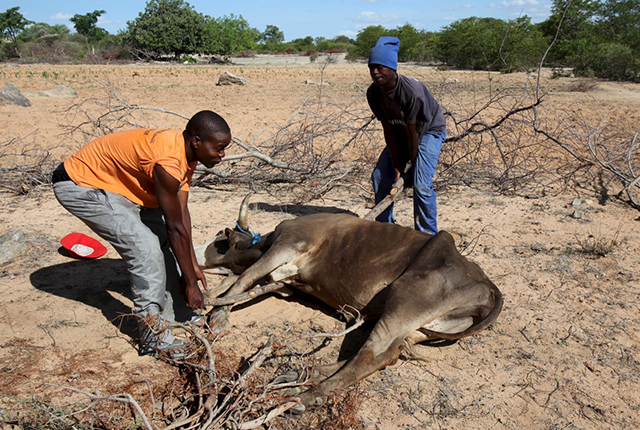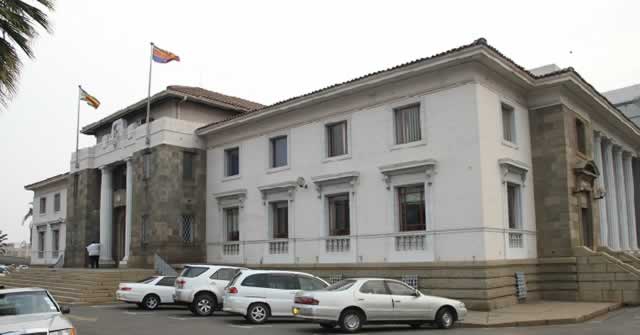Zim response to climate change will determine economic direction

Jeffrey Gogo Climate Change—
IN local climate and environment sectors, the year 2016 may best be forgotten for the devastation brought on by a severe drought linked to El Nino, the continued water crisis and the failure at CITES. There were a few cheerful moments, really — one of them the fast-track entry into force of the Paris Agreement.
Setting in the summer of 2015, the full impact of the El Nino — a periodic weather phenomenon that alters rainfall and temperature patterns worldwide — was only felt post-harvest earlier this year.
As crops failed, with only 25 percent of the annual maize staple requirement produced, more than 4 million people, or a third of Zimbabwe’s population, were left facing hunger, forcing Government authorities to declare the situation a disaster, needing $1,6 billion in aid.
The failure in agriculture, which grew -3,7 percent this year, boomeranged across the economy. Finance Minister Patrick Chinamasa had to downgrade economic growth for 2016 to just 0,6 percent from 1,5 percent previously.
Climate-linked events such as the El Nino — forecast by scientists to increase in frequency and strength due to climate change — present real challenges for developing economies like Zimbabwe’s.
How Zimbabwe prepares for and responds to such events, now and in the future, could be the difference between poverty and wealth, economic growth or decline.
CITES
In September South Africa hosted the 17th meeting of the Conference of Parties to the Convention on International Trade in Endangered Species (CITES).
There was a lot of expectation going into that conference, particularly from Zimbabwe, Namibia and South Africa, for the lifting of a global ban in the commercial trade in ivory.
The other goal was to stop the Cites from banning sales of live elephant and lion, or hunting of such game for sport, completely. Zimbabwe succeeded on this one, but only as far as the next Cites conference in 2019, perhaps earlier
Almost a decade since the last one-off sale, there was a general belief across southern Africa that a Cites conference for which the region was host will let up a bit.
But the evidence of rejection for such hope was heart-breaking. About 75 percent of the Cites members voted to reject a proposal by Zimbabwe, Namibia and South Africa seeking to introduce a mechanism that would allow for trade in ivory in future.
In view of the flawed system at work within Cites, where a few nations with money can influence decisions their way, perhaps it’s high time authorities began to consider options outside the Convention, and, possibly re-evaluate its membership.
Water
Water was a major crisis in 2016, like many years before. Dams dried up owing to El Nino, leaving little for agriculture, domestic and industrial use.
In Harare, reliable water supplies remained a nightmare, throughout the year. Unsurprisingly, disease broke out, typhoid specifically, affecting dozens in poor sprawling ghettoes like Hopley.
The city blames the cuts on depleted water levels at Lake Chivero, its main source, and on extreme pollution from raw sewage and industrial chemical waste.
Harare Residents Trust director, Precious Shumba, said the city supplied only 55 percent of its 2,1 million residents with water, according to their own analysis. The rest rely on private boreholes, community boreholes sunk by aid agencies, streams and on shallow unprotected wells.
Harare’s densely populated townships like Hopley are much more vulnerable to large water-borne outbreaks, with poor hygiene and sanitation everywhere. In some places, wells are sunk within spitting distance of the blair toilet.
This is what makes Harare a perfect breeding ground for disease. And that ground has been under preparation for the past 20 years, made worse by frequent droughts, ballooning population, ageing equipment, poor strategic planning, and runaway pollution.
City authorities must bow their heads in collective shame at this pathological failure to protect residents in a modern metropolis like Harare — the so called Sunshine City — against backward diseases like typhoid.
But thank goodness, the water scarcity, which left Kariba dam nearly empty, barely caused concern in the electricity sector, as was the case between October and December 2015.
Power utility, Zesa Holdings, appeared prepared to avert a repeat of the 18-hour a day power cuts endured by households in 2015 due to reduced water supplies to the Kariba hydro-power station.
Paris Agreement
If Zimbabweans should forget 2016 as a drought year, the world should remember 2016 as a breakthrough in global climate change discourse.
The landmark climate agreement called the Paris Agreement entered into force on November 4, hardly a year after it was agreed, and three years ahead of schedule.
The treaty, which aims to hold temperature increase below 2 degrees Celsius in this century, is widely seen as a crucial global intervention to halt climate change and its attendant socio-economic and environmental problems.
As it turns out, in-coming US president Donald Trump, will be one of the Paris Agreement’s biggest threat — not an unlikely source of confusion though.
A known climate change denialist who believes the dangerous science is a trick, Mr Trump has in the past threatened to rip the landmark Paris Agreement apart, if he became president.
Now that he is president-elect, will Mr Trump make good on his promise and pull the US, the world’s second largest emitter behind China, out of the treaty, achieved after decades of painful negotiations?
We all wait with abated breath.
God is faithful.











Comments